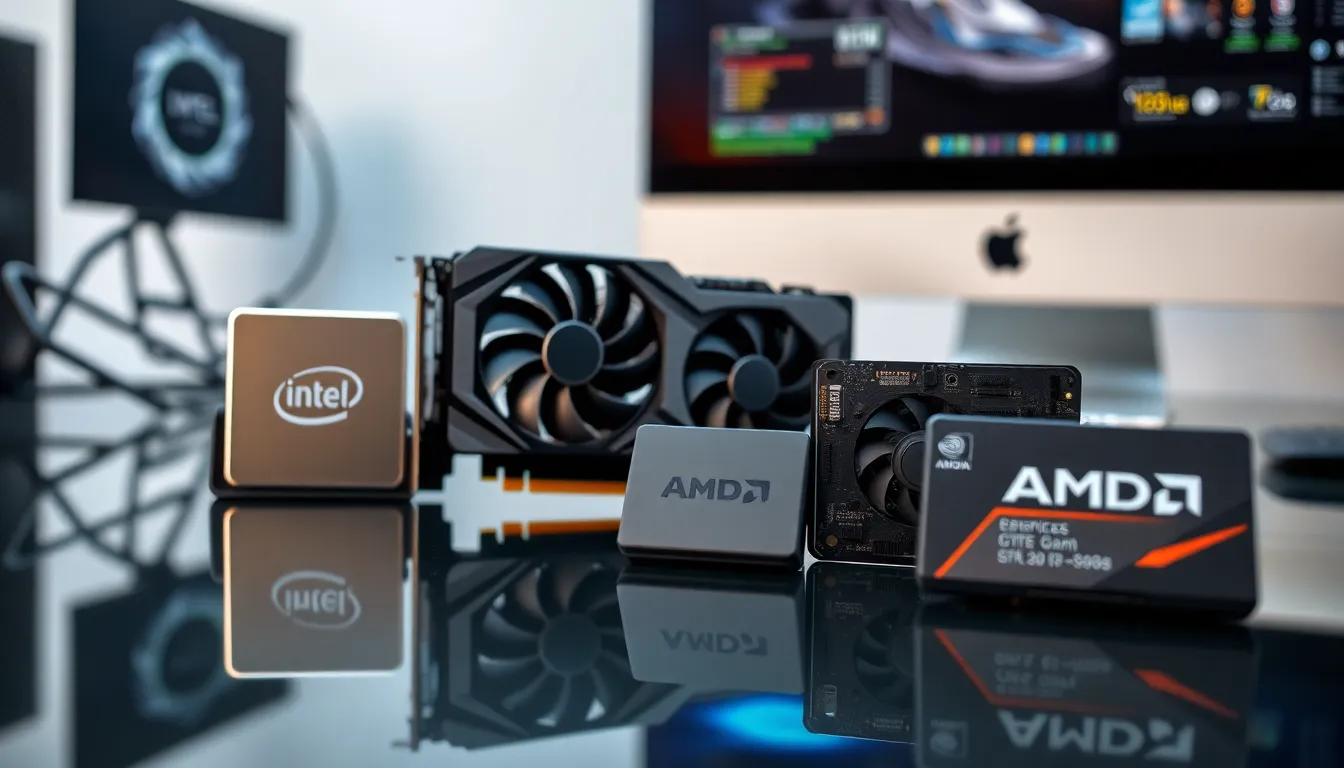Table of Contents
ToggleIn a world where computers seem to have a mind of their own, the unsung heroes are the computer hardware manufacturers. These tech wizards design and build the components that keep our devices humming along like a well-oiled machine. From the humble CPU to the flashy graphics card, they’re the backbone of our digital lives, often working tirelessly behind the scenes while we binge-watch cat videos or conquer virtual worlds.
Overview of Computer Hardware Manufacturers
Computer hardware manufacturers play a vital role in technology’s evolution. They focus on designing and producing essential components, including CPUs, graphics cards, and RAM modules. These components form the backbone of computers and devices, enabling them to operate efficiently.
Various leading companies dominate the market. Intel and AMD are known for their CPUs, steering innovation in performance and energy efficiency. NVIDIA and AMD also compete in the graphics card segment, developing powerful GPUs that enhance gaming and graphic design experiences.
Manufacturers emphasize quality and reliability. Each component undergoes rigorous testing to ensure it meets high standards. Product development often involves feedback from engineers and consumers to address performance needs and emerging technologies.
The manufacturing process requires precision and advanced technology. Automated systems aid in assembly, while quality assurance teams inspect every detail. Many manufacturers leverage sustainable practices to minimize their environmental impact.
Trends indicate a shift towards integration and miniaturization. As devices evolve, manufacturers aim to create compact yet powerful components. This trend fosters innovation in laptops, tablets, and smartphones, impacting user experiences positively.
Understanding the role of manufacturers helps users appreciate the complexity behind a computer’s performance. Without the ingenuity of these manufacturers, the functionality and capabilities of modern technology would not exist, making their contributions indispensable in everyday life.
Major Players in the Industry

The computer hardware manufacturing industry features several key players renowned for their contributions to technology. These companies lead in innovation and quality, offering essential products that drive performance.
Leading Brands and Their Offerings
Intel stands out for its CPUs, delivering robust processing power critical for various computing tasks. AMD also excels in the CPU market, providing high-performance processors that cater to gamers and professionals alike. NVIDIA dominates the graphics card sector, known for its advanced GPUs that enhance gaming and creative applications. Another strong contender is AMD, which produces competitive graphics cards that balance performance with cost-effectiveness. Each brand emphasizes energy efficiency and cutting-edge technology in their offerings, ensuring consumer needs are met effectively.
Emerging Manufacturers to Watch
Several emerging manufacturers reshape the hardware landscape. Companies like ARM focus on efficient chip designs, targeting mobile devices and IoT applications, making them crucial players as demand for smart technology grows. Qualcomm specializes in mobile processors, pushing the boundaries of performance and connectivity in smartphones. Another notable brand is Micron, recognized for its innovative memory solutions that enhance computing speed and efficiency. Each of these manufacturers is gaining traction, demonstrating potential to disrupt established market dynamics with their unique approaches and products.
Comparison of Products and Technologies
Computer hardware manufacturers provide a range of products and technologies critical to modern computing. Details about their performance metrics and design innovations highlight advancements in the industry.
Performance Metrics
Performance metrics serve as vital indicators of component efficiency and capability. Manufacturers often assess CPU speed measured in GHz, which significantly affects processing power. Graphics card performance includes FPS or frames per second, essential for gaming quality. RAM speed, represented in MHz, contributes to system responsiveness and multitasking capabilities. Benchmarking tools like Cinebench and 3DMark provide objective performance ratings, enabling consumers to compare hardware options effectively. Understanding these metrics helps users make informed decisions based on their specific needs.
Innovations in Hardware Design
Innovative hardware design plays a crucial role in improving user experiences. Many manufacturers focus on developing smaller, more efficient components that fit in compact devices. Integration trends lead to system-on-chip (SoC) designs, combining multiple functions into single chips. This approach enhances performance while reducing power consumption. Developments in cooling technologies, like vapor chambers and advanced fan systems, enhance thermal management in high-performance CPUs and GPUs. Manufacturers also prioritize modular designs that allow easy upgrades and repairs, promoting sustainability in the hardware lifecycle. Each innovation contributes to building more powerful and energy-efficient systems.
Market Trends and Future Outlook
The landscape of computer hardware is rapidly evolving, driven by continuous innovation and changing consumer demands. Focus on performance and energy efficiency remains strong, with manufacturers seeking to provide faster, more powerful components.
Emerging technologies are reshaping the market, as manufacturers explore options such as quantum computing and artificial intelligence integration. These advancements aim to enhance computing capabilities across various devices, from personal computers to data centers.
Sustainability practices are now crucial for many manufacturers, prompting shifts towards eco-friendly materials and reduced energy consumption. Companies increasingly prioritize environmental impact alongside performance.
Another trend is the rise of customizable and modular designs, allowing consumers to upgrade their hardware without complete replacements. This flexibility appeals to tech enthusiasts and promotes longevity in product life cycles.
Competitive pressures drive manufacturers to push boundaries in design, leading to smaller and more efficient components. Integration of components into system-on-chip designs serves to streamline devices further, catering to the demand for compact solutions in laptops and smartphones.
In terms of memory and storage, innovations continue to emerge with advancements in solid-state drives and high-speed RAM. These developments significantly improve system responsiveness and overall user experience.
Benchmarking tools play an essential role as consumers increasingly seek transparent performance metrics. Tools like Cinebench and 3DMark empower users to make informed purchasing decisions based on performance data.
Overall, these market trends and forward-looking strategies indicate a vibrant and competitive future for computer hardware manufacturers, with ongoing advancements poised to redefine user experiences in technology.
Challenges Facing Computer Hardware Manufacturers
Computer hardware manufacturers encounter several significant obstacles in an evolving market. Supply chain disruptions often hinder production, impacting the availability of critical components like CPUs and GPUs. Increased demand for high-performance hardware further strains these supply chains, resulting in shortages and delays.
Competition stands as a major challenge. Companies like Intel, AMD, and NVIDIA constantly innovate to maintain an edge, pushing others to reduce costs while enhancing performance. Pressure from emerging manufacturers, such as ARM and Qualcomm, complicates these dynamics. These new players often introduce unique technologies that disrupt traditional markets.
Sustainability remains a pressing concern also. Manufacturers are compelled to adopt eco-friendly practices, balancing operational efficiency with environmental responsibility. Meeting regulations on waste disposal and energy usage adds additional layers to their challenges.
Rising costs of raw materials, including silicon and metals, affect profitability and pricing strategies. As manufacturers strive to offer competitive prices, they face increased scrutiny from consumers expecting higher quality at lower costs.
Finally, the rapid pace of technological advancement presents both opportunities and threats. Staying ahead in innovations related to artificial intelligence and quantum computing requires constant investment. Failure to adapt can lead to obsolescence in a fast-moving industry.
In a landscape marked by constant change, computer hardware manufacturers must navigate these challenges to ensure growth and maintain their essential role in technology.
The landscape of computer hardware manufacturing is evolving rapidly. As technology advances manufacturers are pushed to innovate while balancing performance and sustainability. The emergence of new players like ARM and Qualcomm alongside established giants like Intel and NVIDIA creates a dynamic market.
Consumers benefit from this competition with more efficient and powerful components that enhance their digital experiences. Understanding these manufacturers’ roles highlights the intricate processes behind everyday technology. Their commitment to quality and innovation ensures that users can enjoy seamless performance across devices. As trends shift towards customization and eco-friendly practices the future looks promising for both manufacturers and consumers alike.










